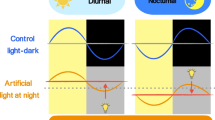Abstract
We studied the effect of injections of melatonin and modifications of the duration of illumination on the activity of 5′-nucleotidase, an enzyme providing synthesis of adenosine, in the forebrain of juvenile male albino rats. The measurements were performed under conditions of acute hypobaric hypoxia. We found that, under conditions of natural illumination, neither isolated injections of melatonin nor acute hypoxia noticeably changed the activity of 5′-nucleotidase. At the same time, acute hypoxia combined with melatonin injections increased the activity of this enzyme. A similar noticeable rise in the activity of 5′-nucleotidase was observed after melatonin injections in normoxic animals kept in constant darkness, and in rats subjected to hypoxia without the above injections but under conditions of constant illumination. These data allow us to suppose that melatonin (whose level in the extracellular medium is a factor providing synchronization of endogenous temporal rhythms) stimulates 5′-nucleotidase-mediated production of adenosine in brain neurons. Acute hypoxia promotes such an effect of melatonin.
Similar content being viewed by others
REFERENCES
R. Marry, D. Grenner, P. Mayes, and V. Rodwell, Biochemistry of Humans [Russian translation], Vol. 2, Mir, Moscow (1993).
V. C. de Sanchez, “Circadian variations of adenosine and of its metabolism. Could adenosine be a molecular oscillator for circadian rhythms?” Can.J.Physiol.Pharmacol., 73, No. 3, 339–355 (1995).
E. M. Khvatova, A. N. Sidorkina, and G. V. Mironova, Nucleotides in the Brain (Metabolism and Estimates under Conditions of Oxygen Deficiency) [in Russian], Meditsina, Moscow (1987).
I. I. Zamorskii, V. P. Pishak, and I. F. Meshchishen, “Effect of melatonin on photoperiodic changes in the glutathione system in the brain under conditions of acute hypoxia, ” Fiziol.Zh., 45, No. 4, 69–76 (1999).
I. I. Zamorskii, V. P. Pishak, and G. I. Khodorovskii, “Effect of melatonin on the levels of corticosterone and prolactin in the blood plasma of rats under conditions of varied photoperiodicity and acute hypoxia, ” Endokrinologiya, 5, No. 1, 22–28 (2000).
V. A. Berezovskii, K. A. Boiko, K. S. Klimenko, et al., Hypoxia and Individual Peculiarities of Responsiveness [in Russian], Naukova Dumka, Kyiv (1978).
V. N. Anisimov, “Physiological functions of the epiphysis (a gerontological aspect), ” Sechenov Ross.Fiziol.Zh., 83, No. 8, 1–13 (1997).
R. J. Reiter, “Functional pleiotropy of the neurohormone melatonin: antioxidant protection and neuroendocrine regulation, ” Front.Neuroendocrinol., 16, No. 4, 383–415 (1995).
N. K. Malinovskaya, “Role of melatonin in the human organism, ” Klin.Med., No. 10, 15–22 (1998).
B. Israelsson and I. Tengrup, “Changes in adenylate cyclase and 5´-nucleotidase activities in liver membranes from alloxan diabetic rats, ” Experientia, 36, No. 2, 257–258 (1980).
S. Fiske and J. Subbarow, “The colorimetric determination of phosphorus, ” J.Biol.Chem., 66, No. 7, 375–400 (1925).
O. H. Lowry, N. J. Rosenbrough, A. L. Farr, and R. J. Randall, “Protein measurement with the folin phenol reagent, ” J.Biol.Chem., 193, No. 1, 265–275 (1951).
I. N. Man'kovskaya, G. L. Vavilova, O. N. Kharlamova, et al., “Activity of marker enzymes of cell membranes in rats under conditions of adaptation to hypoxic hypoxia, ” Ukr. Biokhim.Zh., 69, No. 2, 79–87 (1997).
D. Cardinali, M. Vacas, R. Rosenstein, and H. Chuluyan, “Multifactorial control of pineal secretory activity, ” in: 31st International Congress of Physiological Science (Helsinki, July 9–14, 1989), Abstr., Oulu (1989), p. 466.
Author information
Authors and Affiliations
Rights and permissions
About this article
Cite this article
Zamorskii, I.I., Pishak, V.P. Effect of Melatonin on the Intensity of Adenosine Production in the Rat Forebrain under Conditions of Acute Hypoxia and Varied Photoperiodicity. Neurophysiology 35, 44–47 (2003). https://doi.org/10.1023/A:1023998306826
Issue Date:
DOI: https://doi.org/10.1023/A:1023998306826




